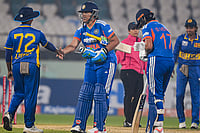What an irony that the seeming vindication by Wikileaks and the Japanese nuclear crisis of the Left’s stand on the Indo-US nuclear cooperation bill, voted in by the last Lok Sabha, will not matter much in the forthcoming assembly elections in five states. The Left’s opposition to the bill, in the name of not allowing India’s subordination to US interests, resulted in the severance of ties with the Congress-led UPA-I. But—some would say not surprisingly—the issue did not matter in the Lok Sabha elections that brought UPA-II to power.
In the old discourse, the Left’s denunciation of imperialism, represented by the US and western powers, gelled with the denunciation of capital, for imperialism was explained as the highest form of exploitative capitalism. This was disseminated by the Communists in a potent communication package in their strongholds to charge a politically organised underclass, especially in the light of US adventurism in Indo-China and West Asia. But, as the anti-big capital stance of the Marxists blurred markedly in the context of Singur and Nandigram, there was a disconnect on the other count too between the Left and its audience. In fact, the parliamentary Left had lost the dialogue for quite some time, especially with voters born after 1977 in its strongholds of West Bengal, Tripura and Kerala and also in other states. While large sections of these young people were charged by aspirational goals and sought individual upward mobility in opportunities provided by the new economic dream-world forged in the 1990s, another section of resentful laggards was mobilised for communal politics. And in the absence of an innovative Left, it was either left to new social movements and NGOs to give voice to the underclass that was the victim of neo-liberal policies or to the Maoists to lead this underclass into armed conflict. The shibboleths of the Soviet era were unhelpful in communicating with and mobilising the youth of the world being fashioned in a globalising, neo-liberal image.
Till as long as the post-1977 generation had not come of political age in the Leftist bastions of West Bengal, Tripura and Kerala, a crisis did not stare the Left hard in the eyes, even though the Leftist presence outside of these states kept crumbling through the 1990s. This was manifest in the gradual decline of seats held in the legislatures of and representation in Parliament from states like Bihar, Maharashtra, Andhra Pradesh, Tamil Nadu and Uttar Pradesh; the gradual loss in the clout of Left-run trade unions; and the failure of these unions and other organisations to record a significant presence in the huge unorganised sector that the new economy has spawned.
What lulled the Left into complacence was initially its increased national political clout as part of a ‘Third Front’, comprising regional parties and parties of socialist and other lineage that had either channelised caste inequalities or intermediate groups’ concerns, issues to which the Left had been generally indifferent. And recently, it was falsely emboldened by its highest ever parliamentary representation and clout during the last Lok Sabha, aided by its victory over a disunited opposition in West Bengal and its cyclical performance in a bipolar Kerala polity. The Communists made most of it by forcing a few welcome policy correctives on UPA-I in favour of the aam admi. But the last Lok Sabha elections, recording the Left’s lowest tally of 24 seats in recent decades, finally shook the Left awake, forcing it to face reality.
Commentators on both sides of the polarity agree that the Left’s possible poor showing in the upcoming assembly elections will propel a general rightward shift in politics and government policies and the relevance of the idea of a ‘Third Front’ will become even flimsier, pushing India towards bipolar coalition politics. But few have dwelt on the challenges such a result will throw for the Left itself. Not Kerala, but a defeat in West Bengal will create a very hostile political environment for the Left. Facing which, its opportunistic elements might quickly switch loyalties to the new ruling dispensation, while the Maoists might progressively encroach upon the committed cadre base of the mainstream Left to lay claim to the real ideological inheritance of Communism. The future of the current parliamentary Left will be determined by how it meets this twin challenge at the cutting edge in West Bengal. And also how it innovates to build up a new dialogue with a changed world and reaches out to the classes marginalised by a changed economy. Much would also depend on how (and whether) the Left will forge a coalition with smaller new movements, with whom it lost its dialogue during Singur and Nandigram, and old political platforms that would feel disoriented in a rigid bipolar arrangement.


























